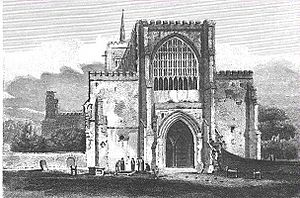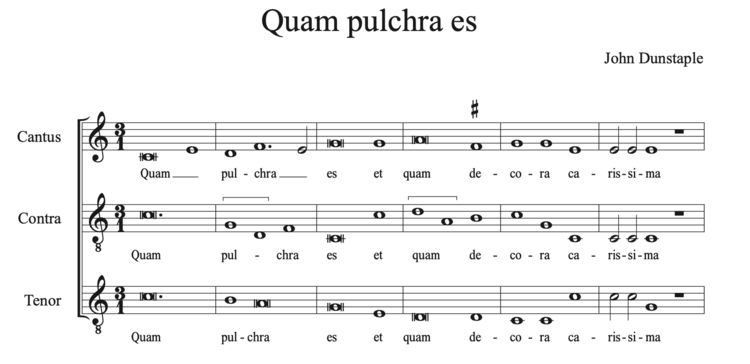John Dunstaple facts for kids

John Dunstaple (or Dunstable, c. 1390 – 24 December 1453) was an important English composer. His music helped change music from the Middle Ages to the Renaissance period. He was known for a style called Contenance angloise (which means "English manner").
Dunstaple was the most famous English composer of his time. People often compare him to William Byrd and Henry Purcell as one of England's most important early composers. The music we still have from him is all sung. He often used isorhythms, which are repeating patterns in music. He also started using harmonies with thirds and sixths a lot, which was new and exciting. His style greatly influenced composers in Europe, like Du Fay and Binchois.
We don't know much about Dunstaple's life. The only sure date we have is his death on Christmas Eve in 1453. He was probably born in Dunstable, Bedfordshire, in the late 1300s. He worked for important people like Humphrey, Duke of Gloucester and Queen Joan of Navarre. Because of them, he also had ties to St Albans Abbey. Another important person he worked for was John of Lancaster, Duke of Bedford. Dunstaple might have even traveled to France with him.
Life and Work
We don't know much for sure about John Dunstaple's early life or where he came from. Because of this, many stories and ideas about him have been made up over time. Some old writings even confused him with a saint from the 900s!
Most experts believe Dunstaple was born around 1390. This guess comes from his earliest music, which appeared between 1410 and 1420. His family name probably came from the town of Dunstable in Bedfordshire. Even though the town is spelled with a 'b', most old music papers spell his name 'Dunstaple' with a 'p'.
We don't know how he learned music. He was clearly a very smart person, but there are no records of him going to Oxford or Cambridge universities.
Working for Royalty
It's believed that Dunstaple worked for John of Lancaster, Duke of Bedford. The Duke of Bedford was the fourth son of King Henry IV and brother of King Henry V. Because of this job, Dunstaple might have lived in France for some time. The Duke of Bedford was in charge of France from 1423 to 1429. He was also the Governor of Normandy from 1429 until he died in 1435.
Dunstaple owned land in Normandy, as well as in England in places like Cambridgeshire, Essex, and London. After another person he worked for, Queen Joan, died in 1437, he likely worked for Humphrey, Duke of Gloucester. Humphrey was the fifth son of King Henry IV.
More Than a Musician
Unlike many composers of his time, Dunstaple was probably not a priest. He might have been married, as records show women with his name in his local church area. He also owned a large house in Hertfordshire.
Besides being a composer, Dunstaple was also known as an astronomer, astrologer, and mathematician. Some of his writings about astrology still exist today.
Dunstaple had special connections with St Albans Abbey:
- The abbot (head) of the abbey, John Whethamstede, knew the Duke of Gloucester. Dunstaple wrote a special piece of music called Albanus roseo rutilat for St Albans. It might have been for a visit by the Duke of Bedford in 1426.
- In 1452–53, Abbot Whethamstede planned a grand library for the abbey. It was going to have twelve stained glass windows, each showing a different area of learning. The verses the abbot wrote for these windows clearly mention Dunstaple. They talk about his knowledge not just in music, but also in astronomy, medicine, and astrology.
Dunstaple owned two important books by a writer named Boethius. These books were about music and arithmetic.
Dunstaple died on Christmas Eve, 1453. He was buried in the church of St Stephen Walbrook in London. His tomb was destroyed in the Great Fire of London in 1666, but a new marker was put in the church in 1904. His tombstone said he had "secret knowledge of the stars."
His Music
England produced a lot of music in the Middle Ages. However, most of the music papers were destroyed during the English Reformation. This happened especially when monasteries were closed between 1536 and 1540. Because of this, most of Dunstaple's music has been found in other countries, mainly in Italy and the southern Alps.
Many copies of his music were found in Italian and German papers, which shows how famous he was. It can be hard for music experts to figure out which old, unnamed pieces were written by him. Sometimes, the same piece of music is said to be by Dunstaple in one source, but by another composer in a different source.
About 50 of his works are still known today. These include two complete masses (long pieces of church music), parts of other masses, and 12 complete motets. A motet is a type of sacred choral music. One famous motet combines two hymns, Veni creator spiritus and Veni sancte spiritus. He also wrote 27 other pieces for church services, including seven settings of Marian antiphons, like Alma redemptoris Mater.
Dunstaple was one of the first composers to write masses using a single melody called a cantus firmus. This means he used a main tune that stayed the same throughout the piece. His Missa Rex seculorum is a good example of this.
People believe he also wrote non-religious music, but we don't have any songs with everyday words that we can be sure he wrote. A popular song called "O rosa bella" was once thought to be by Dunstaple, but now it's believed to be by John Bedingham. Many old English carols from his time don't have a composer's name. Experts think it's very likely that some of these unnamed carols were actually written by Dunstaple.
His Influence
Dunstaple had a huge impact on music in Europe, even though not many of his pieces have survived. He was known for something new in music called la contenance angloise ("the English countenance" or "English manner"). A poet named Martin le Franc used this term to describe his style. Le Franc said that this style influenced famous composers like Dufay and Binchois. This was high praise!
Later, around 1476, a composer and music expert named Tinctoris also talked about Dunstaple's strong influence. He said Dunstaple started a "new art" in music. Tinctoris called Dunstaple the fons et origo of this style, meaning its "wellspring and origin."
The "English manner" probably referred to Dunstaple's way of using full triadic harmony. This means he used chords made of three notes that sounded very rich. He also liked to use the musical interval of the third. If Dunstaple traveled to Europe with the Duke of Bedford, he would have learned about French fauxbourdon, a style of singing. He took some of these sounds and created beautiful harmonies in his own music using thirds and sixths.
These musical ideas are seen as key features of early Renaissance music. The comments from Le Franc and Tinctoris suggest that many of these new musical ideas might have started in England. They then became popular in Europe around the middle of the 1400s.
See also
 In Spanish: John Dunstable para niños
In Spanish: John Dunstable para niños


